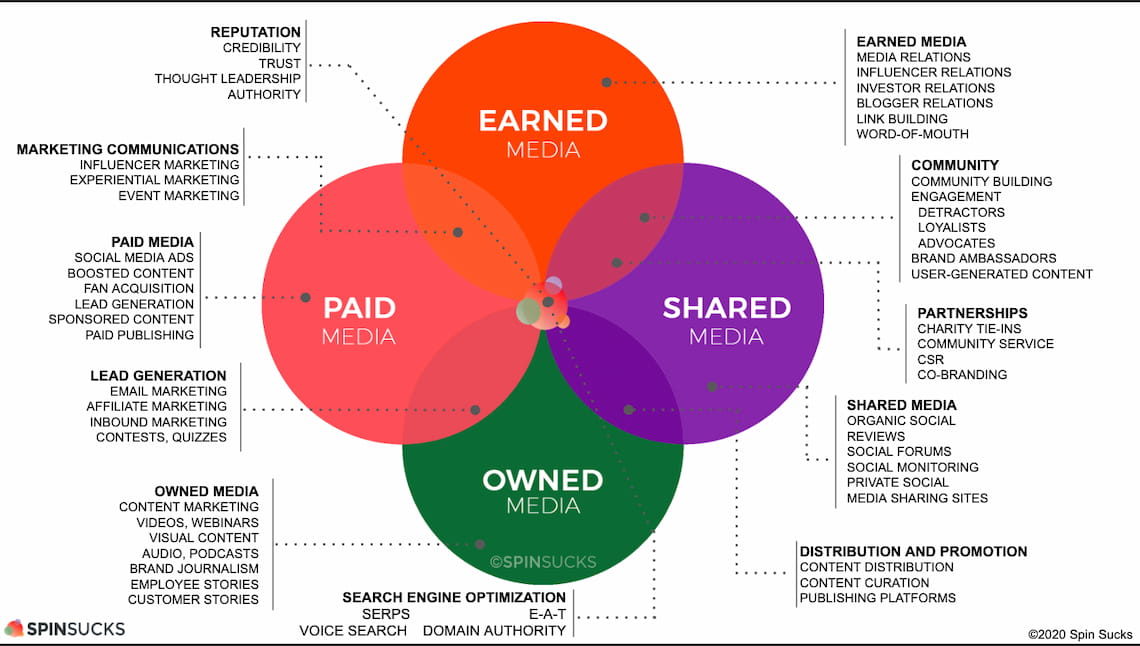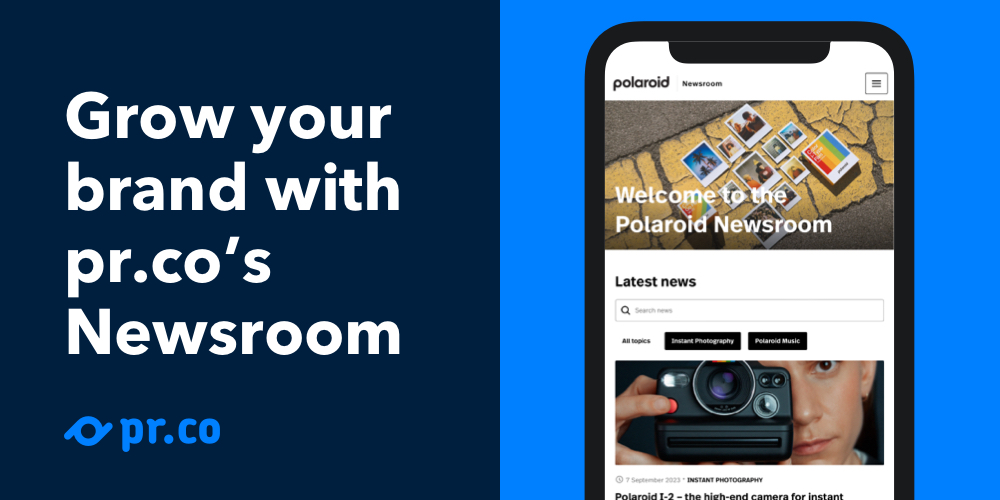Earned media is going belly up.
With more than half of U.S. adults and 42% of younger Europeans now getting their news from social media platforms, relying on traditional media to amplify your brand doesn’t cut it anymore.
Also, with public trust in mainstream media sources lower than ever, PR is becoming less about grabbing headlines and more about genuinely connecting with audiences to earn their loyalty and trust.
Does this mean it’s time to bury the “earned” part of the PESO model?
While it’s not quite time to write its obituary, savvy PR pros are rethinking what “earned” means. In fact, they’re shifting the focus of their PR & marketing efforts from media relations to genuine engagement to usher in a new era of “earned attention.”
Unpacking the ‘E’ in PESO
Let’s quickly revisit Gini Ditriech’s original PESO model to understand this shift.

Dietrich’s brand, Spin Sucks, defines the PESO model as “an integrated approach to communications that blends paid, earned, shared, and owned media to establish thought leadership, credibility, trust, and authority that fuel a brand reputation.”
Earned media is generated when third parties such as journalists, bloggers, influencers, or customers voluntarily share, mention, or review a brand, product, or service. Common examples include news articles, editorial features, interviews, positive reviews, word-of-mouth recommendations, and organic social media mentions.
This media coverage differs from paid or owned media, which refers to all the content and channels your brand fully controls — think blog posts, press releases, your company's branded newsroom or social media accounts.
The Changing Landscape of Earned Media
What has changed over the last few years?
For starters, the media landscape is now far more fragmented and varied. Instead of turning to traditional outlets, potential customers are heading straight to social media channels, podcasts, blog posts, review sites, Substacks, and Reddit threads to find information and opinions they trust.
Another major shift is the explosion of user-generated content (UGC). Consumers are tuning in to voices they see as peers (i.e., influencers and reviewers) instead of journalists and media outlets to find the brand information they seek.
.jpg?width=1280&height=853&name=DTS_Mood_board_Julien_Tell_Photos_ID3502%20(2).jpg)
Lastly, search engines play a huge role in visibility. Algorithms curate our feeds so precisely that the content people encounter often comes from outside mainstream media. Donald Trump, for example, famously leveraged social media to bypass traditional news outlets and speak directly to his supporters, using platforms like X (formerly Twitter).
All of this adds up to the fact that the value of traditional earned media has changed. Many of today’s potential customers are more influenced by endorsements from content creators and peer reviews than by an organic mention in the Wall Street Journal.
For brands, this means a rethink of where—and how—they amplify their messages.
The Brave New World of ‘Earned Attention’
With traditional earned media moving to the sidelines, PR professionals are now focusing on capturing “earned attention.”
This approach encourages voluntary engagement and working with your target audience’s responses and behaviors to capture their hearts and minds, notes award-winning strategic communications executive and author Dan Nestle.
Unlike traditional earned media, the earned attention approach focuses on building brand awareness within highly targeted communities, giving relevant creators the valuable content they need, and encouraging active participation rather than passive brand exposure. This shift is changing how PR fits within a brand's digital marketing strategy — integrating influencer collaborations, social media ads, and targeted campaigns to meet audiences where they are.
Gini Dietrich adds that earned media must evolve to incorporate “platform relations”. This involves understanding and respecting each community or platform’s unique culture and content preferences.
“Success requires moving beyond simple platform presence to genuine community participation,” Gini writes. “We need to become fluent in the language and norms of each platform where our audiences gather.”
Brands Must Form Part of the Conversation
Today’s PR pros must position their brands as active participants in their target audience’s conversations. This includes building relationships with journalists and other community members, identifying potential brand advocates, and supporting and empowering these advocates to get your brand messages across.
One of the most interesting—and, dare we say, challenging—aspects of the earned attention era is that brands must loosen their grip on “the narrative.”
Instead of tightly controlling every message, the key is to create a space for genuine community participation. This means trusting your audiences and advocates to let the conversation evolve organically. As Gini sums up: “It’s a brave new world, my friends!”
Shifting Gears From ‘Earned Media’ to ‘Earned Attention’
Today’s changing PR landscape demands a shift from rigid message control to authentic storytelling, transparency, and genuine connection with target audiences.
PR teams must embrace new strategies and tools to keep up, prioritizing wider audience engagement over traditional media coverage. Fortunately, the rise of real-time analytics means tracking what truly resonates is easier than ever. Metrics like social media shares, clicks, comments, and dwell time help teams see which messages or stories capture attention and which channels deliver results.
This data-driven approach empowers PR pros to be more agile, refining campaigns on the fly and doubling down on what works. Instead of waiting for coverage in legacy outlets, teams can quickly identify opportunities to reach audiences who are already active and engaged.
.jpg?width=1280&height=853&name=DTS_INFLUENCER_Daniel_Far%C3%B2_Photos_ID8212%20(1).jpg)
Dan puts it well: “With an audience-centric, attention-driven approach, we would choose a variety of high-relevance, high-resonance channels, secure more earned opportunities with less time and money, and make changes on the fly to adjust to changing business needs.”
In short, the future of PR belongs to those who can adapt quickly, experiment boldly, and put audience attention at the heart of their strategies.
Rolling Out Your Earned Attention Strategy
Unfortunately, there’s no magic formula for nailing earned attention—what works for one brand might flop for another. But there are a few practical PR tips you can use to get started.
Focus on:
- Content formats that encourage interaction: Videos, live events, and animated infographics are far more engaging than static text. Modern audiences also prefer short, visual formats to longer written content. These messages are more likely to be shared and prioritized by social algorithms (especially if the content has strong engagement signals).
- Target the right platforms: Pinpoint the platforms where your audience is most active, and start building brand communities there. This might mean revisiting and refining your current audience segments. Tools like Brandwatch or Sprout Social can help you zero in on the right platforms and identify industry experts or influential voices to connect with. A word of warning: Do your research carefully and keep the “platform relations” concept (described above) firmly in mind. Nothing burns bridges faster than jumping in without a real understanding of both the platform and the community. (Just ask Woody Harrelson’s PR team.)
- Focus on storytelling and values: Earned attention is all about deepening the connection with your audience, and there’s no better way to do this than by telling a great story. Brush up on your brand journalism skills. Also, pay close attention to audience values and take the time to create narratives that would really resonate.
- Tap into new spaces and tech: It’s not just social platforms and influencers that PR teams need to keep an eye on. Immersive environments like AR and VR spaces are quickly gathering their own vibrant communities.Connecting with audiences in these environments requires a little more planning (and some tech know-how). As a start, think AR product demos or persistent VR spaces. A good example is the Gucci and Vans collaboration on Roblox, where players can go on scavenger hunts or interact wearing virtual branded merch.
Build Authentic Brand Engagement With PR.co
Where does all of this leave the PESO model’s “E?”
Earned attention is here to stay, but it isn’t replacing earned media anytime soon. Think of the original “E” as being part of a bigger “E”-cosystem: One where community conversations, influencer shoutouts, and shareable content sit alongside traditional media placements to establish brand awareness, credibility, and, ultimately, loyalty.
Adapt to this brave new world by keeping your target audience front and center, and making your content discoverable, easy to share, and ready to go when the right opportunity arises.
Remember that PR.co’s custom newsrooms give you the tools you need to win at earned media and earned attention. From managing brand assets and press releases to real-time analytics and campaign content, our platform keeps it all in one place, empowering you to craft and distribute impactful content in record time.
Curious to discover how PR.co can help you grow your brand? Book a demo.
Ana is a marketer at pr.co, and is the driving force behind our 100+ articles and guides. Ana has an MSc in Corporate Communications, and four years of experience in the PR industry. Now, Ana distills knowledge from pr.co’s 250+ customers to help PR professionals get better results through high-quality content.. Connect on LinkedIn or send an email



